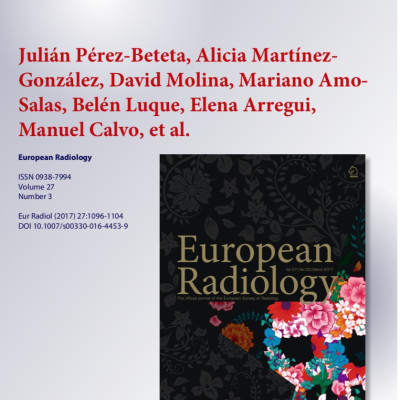Publication
Glioblastoma: Does the pre-treatment geometry matter? A postcontrast T1 MRI-based study
J. Pérez-Beteta, A. Martínez-González, D. Molina, M. Amo, B. Luque, E. Arregui, M. Calvo, J. M. Borrás, C. López, M. Claramonte, J. Barcia, L. Iglesias, J. Avecillas, D.Albillo, M. Navarro, J.M. Villanueva, J.C. Paniagua, J. Martino, C. Velasquez, B. Asenjo, M. Benavides, I. Herruzo, M.C. Delgado, A. Del Valle, A. Falkov, P. Schucht, E. Arana, L. Pérez-Romasanta, V. M.Pérez-García
European Radiology 27(3), 1096-1104 (2017)
MOLAB authors
Amo Salas, Mariano. Pérez García, Victor M.. Martínez González, Alicia. Molina García, David. Pérez Beteta, Julián. del Valle Benavides, Ana. Albillo Labarra, José David. Arana Fernández de Moya, Estanislao. Schucht, Philippe. Asenjo Martínez, Beatriz. Luque Sánchez, Belén. Benavides, Manuel. Pérez Romasanta, Luis. Herruzo Cabrera, Ismael. Velásquez Rodríguez, Carlos.
Abstract
Background: The potential of simple geometrical measures of postcontrast MRI T1 sequences of glioblastoma (GBM) patients as predictors of clinical outcome has been controversial. Results have been limited by a combination of: the use of small samples, limited resolution MRIs, inclusion of treated patients, etc. Recent mathematical models of GBM growth have also suggested a possible existence of a connection between some geometrical measures, such as the width of the contrast enhancing (CE) areas, with the tumor aggressiveness.
Methods: A multicenter retrospective clinical study was developed to study high resolution (MRI resolution around or below 1 mm) T1+Gd MRIs of patients with histologically confirmed primary glioblastomas. 117 patients were included from six hospitals. Tumors were semiautomatically segmented and a set of 22 geometrical measures computed including: Contrast enhancing volume, necrosis volume, total volume, maximal tumor diameter, equivalent spherical contrast enhancing width and measures of the CE ‘rim’ such as the positions of the quartiles of the distributions of distances within the rim. The significance of the measures was studied using proportional hazards analysis and Kaplan-Meier curves and the relations between the variables assesed through the computation of correlation coefficients.
Results: Kaplan-Meier survival analysis showed that total volume (P = 0.034), CE volume (P = 0.017), spherical rim width (P = 0.007) and the geometric heterogeneity GH (P = 0.015) were significant predictors of survival. Multivariable proportional hazards analysis provided two age-adjusted parameters as predictors of survival: the contrast enhancing spherical width (P = 0.043, HR = 1.536) and the geometric heterogeneity GH (P = 0.032, HR = 1.570).
Conclusion: he geometry of the contrast enhancing areas in postcontrast T1 pretreatment images measured through (i) a simple measure of the width of the contrast enhancing rim (as predicted by a previous mathematical model), and (ii) the geometric heterogeneity of the rim, are both powerful predictors of survival providing useful prognostic imaging biomarkers in glioblastoma.















